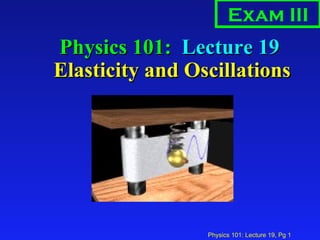Lecture19
•Als PPT, PDF herunterladen•
0 gefällt mir•980 views
Melden
Teilen
Melden
Teilen

Weitere ähnliche Inhalte
Was ist angesagt?
Was ist angesagt? (19)
Important Notes - JEE - Physics - Simple Harmonic Motion

Important Notes - JEE - Physics - Simple Harmonic Motion
Hsc physics revision for oscillation and elasticity

Hsc physics revision for oscillation and elasticity
Andere mochten auch
Andere mochten auch (20)
_upperintermediate_b2_advanced_c1_adult_element_1955050ead696bf6ad9_07697483

_upperintermediate_b2_advanced_c1_adult_element_1955050ead696bf6ad9_07697483
Ähnlich wie Lecture19
Ähnlich wie Lecture19 (20)
Introduction to oscillations and simple harmonic motion

Introduction to oscillations and simple harmonic motion
Periodic Motion KKKKKKKKKKKKKKKKKKKKKKKKKKKKKKKKKKKK.ppt

Periodic Motion KKKKKKKKKKKKKKKKKKKKKKKKKKKKKKKKKKKK.ppt
Quick run through on classical mechancis and quantum mechanics 

Quick run through on classical mechancis and quantum mechanics
Ordinary Differential Equations And Their Application: Modeling: Free Oscilla...

Ordinary Differential Equations And Their Application: Modeling: Free Oscilla...
APPLICATION OF HIGHER ORDER DIFFERENTIAL EQUATIONS

APPLICATION OF HIGHER ORDER DIFFERENTIAL EQUATIONS
Mehr von nomio0703
Mehr von nomio0703 (20)
Kürzlich hochgeladen
Kürzlich hochgeladen (20)
Web Form Automation for Bonterra Impact Management (fka Social Solutions Apri...

Web Form Automation for Bonterra Impact Management (fka Social Solutions Apri...
Apidays Singapore 2024 - Scalable LLM APIs for AI and Generative AI Applicati...

Apidays Singapore 2024 - Scalable LLM APIs for AI and Generative AI Applicati...
Connector Corner: Accelerate revenue generation using UiPath API-centric busi...

Connector Corner: Accelerate revenue generation using UiPath API-centric busi...
Emergent Methods: Multi-lingual narrative tracking in the news - real-time ex...

Emergent Methods: Multi-lingual narrative tracking in the news - real-time ex...
Apidays Singapore 2024 - Building Digital Trust in a Digital Economy by Veron...

Apidays Singapore 2024 - Building Digital Trust in a Digital Economy by Veron...
Strategies for Unlocking Knowledge Management in Microsoft 365 in the Copilot...

Strategies for Unlocking Knowledge Management in Microsoft 365 in the Copilot...
Strategies for Landing an Oracle DBA Job as a Fresher

Strategies for Landing an Oracle DBA Job as a Fresher
How to Troubleshoot Apps for the Modern Connected Worker

How to Troubleshoot Apps for the Modern Connected Worker
Why Teams call analytics are critical to your entire business

Why Teams call analytics are critical to your entire business
Apidays New York 2024 - The Good, the Bad and the Governed by David O'Neill, ...

Apidays New York 2024 - The Good, the Bad and the Governed by David O'Neill, ...
Apidays New York 2024 - The value of a flexible API Management solution for O...

Apidays New York 2024 - The value of a flexible API Management solution for O...
Apidays New York 2024 - Scaling API-first by Ian Reasor and Radu Cotescu, Adobe

Apidays New York 2024 - Scaling API-first by Ian Reasor and Radu Cotescu, Adobe
"I see eyes in my soup": How Delivery Hero implemented the safety system for ...

"I see eyes in my soup": How Delivery Hero implemented the safety system for ...
ICT role in 21st century education and its challenges

ICT role in 21st century education and its challenges
Lecture19
- 1. Physics 101: Lecture 19 Elasticity and Oscillations Exam III
- 3. Hour exam results Avg (ex 1&2), max grade, median grade, min grade 53- 56 C-, D-, F N: 10 57- 60 C, D+, F N: 18 61- 64 C+, D+, F N: 19 65- 68 B+, C, D N: 37 69- 72 A-, C, D- N: 52 73- 76 A-, C+, D- N: 52 77- 80 A, B, D- N: 55 81- 84 A+, B+, C- N: 39 85- 88 A+, A-, D- N: 47 89- 92 A+, A, C N: 32 93- 96 A+, A+, A- N: 22 97-100 A+, A+, A+ N: 03
- 12. Springs and Simple Harmonic Motion X=0 X=A X=-A X=A ; v=0 ; a=-a max X=0 ; v=-v max ; a=0 X=-A ; v=0 ; a=a max X=0 ; v=v max ; a=0 X=A ; v=0 ; a=-a max
- 16. What does moving in a circle have to do with moving back & forth in a straight line ?? R 8 7 8 7 x y x -R R 0 1 1 2 2 3 3 4 4 5 5 6 6 x = R cos = R cos ( t ) since = t
- 17. SHM and Circles
- 18. Simple Harmonic Motion: x(t) = [A]cos( t) v(t) = -[A ]sin( t) a(t) = -[A 2 ]cos( t) x(t) = [A]sin( t) v(t) = [A ]cos( t) a(t) = -[A 2 ]sin( t) x max = A v max = A a max = A 2 Period = T (seconds per cycle) Frequency = f = 1/T (cycles per second) Angular frequency = = 2 f = 2 /T For spring: 2 = k/m OR
Hinweis der Redaktion
- 1
- Example: Given m,k and A and x(0), choose x(t), v(t), a(t), Calculate v_max and a_max, period, energy, K, U
- Example: Given m,k and A and x(0), choose x(t), v(t), a(t), Calculate v_max and a_max, period, energy, K, U
- Example: Given m,k and A and x(0), choose x(t), v(t), a(t), Calculate v_max and a_max, period, energy, K, U
- Example: Given m,k and A and x(0), choose x(t), v(t), a(t), Calculate v_max and a_max, period, energy, K, U